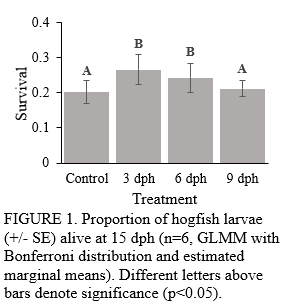UTILIZING THE ONTOGENY OF DIGESTIVE ENZYME ACTIVITY AND DIGESTIVE TRACT MORPHOLOGY TO GUIDE LARVAL CULTURE PROTOCOLS FOR HOGFISH Lachnolaimus maximus
Hogfish (Lachnolaimus maximus) are large reef-dwelling wrasses endemic to Florida and the Caribbean. Florida L. maximus populations are popular targets for commercial and recreational fishers, which has led to increased management and concern regarding population status over the past several decades. Developing aquaculture protocols for this species would allow for the commercial production to meet market demands while simultaneously creating opportunities for stock enhancement. To date, no commercial culture protocols for L. maximus have been developed. First, larval development and nutritional requirements must be discerned for optimiz ation of larval survival in the culture environment. Characterizing the ontogeny of digestive enzyme activity and digestive tract morphology will give insight into digestive capacity and potential nutritional protocols. Fertilized L. maximus embryos were collected, hatched, and raised on live feeds including copepods, rotifers, and Artemia nauplii for 45 days. Larvae were sampled throughout the trial to analyze growth, digestive enzyme activity, and digestive tract development. The activities of lipase, trypsin, and pepsin were analyzed using microplate spectrophotometric assays and digestive tract development was visualized using histology. The data from this trial was used to design a weaning experiment to transition L. maximus larvae from costly, labor-intensive copepod nauplii to more cost-efficient rotifers. Newly hatched L. maximus larvae were assigned one of four feeding regimes: copepods only (control) or rotifer transition at three , six , or nine dph with a three-day cofeeding period and six replicates per treatment . After 15 days, larvae were harvested and assessed for growth and survival. Larvae transitioned from copepods to rotifers at three and six dph had significantly greater survival compared to the other treatments (Figure 1). Total length was significantly lower in the control group compared to all other treatment groups. These results show that growing L. maximus larvae may be less laborious and costly to grow compared to other marine finfish that require prolonged periods of dietary copepods.
